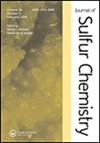关于硫代苯甲醚及其一些甲氧基取代衍生物的质子化和氘化†
IF 2.1
3区 化学
Q3 CHEMISTRY, MULTIDISCIPLINARY
引用次数: 0
摘要
采用1H NMR波谱法研究了强酸(如三氟乙酸或三氟甲烷磺酸)对硫代茴香醇的质子化作用,包括用氘酸进行的实验。与文献报道和一般预期相反,硫代苯甲醚的质子化并不只发生在甲基巯基上,而且在芳香环上也有较低程度的质子化。在甲氧基取代硫代茴香醇的情况下,质子化可以发生在杂原子基团和芳环上。质子化的位置取决于取代基的模式,这是氘化所明确指出的。图形抽象本文章由计算机程序翻译,如有差异,请以英文原文为准。
On the protonation and deuteration of thioanisole and some of its methoxy-substituted derivatives†
The protonation of thioanisols by strong acids, such as trifluoroacetic acid or trifluoromethane sulfonic acid was investigated by 1H NMR spectroscopy, including experiments with deuterated acids. Contrary to reported literature and to general expectations, protonation of thioanisole does not occur exclusively at the methylmercapto group but also to a lower extent at the aromatic ring. In cases of methoxy-substituted thioanisols protonation can take place at both heteroatomic groups and at the aromatic ring. The sites of protonation depend on the substituent pattern as unambiguously indicated by deuteration.
求助全文
通过发布文献求助,成功后即可免费获取论文全文。
去求助
来源期刊

Journal of Sulfur Chemistry
CHEMISTRY, MULTIDISCIPLINARY-
CiteScore
4.10
自引率
9.10%
发文量
38
审稿时长
6-12 weeks
期刊介绍:
The Journal of Sulfur Chemistry is an international journal for the dissemination of scientific results in the rapidly expanding realm of sulfur chemistry. The journal publishes high quality reviews, full papers and communications in the following areas: organic and inorganic chemistry, industrial chemistry, materials and polymer chemistry, biological chemistry and interdisciplinary studies directly related to sulfur science.
Papers outlining theoretical, physical, mechanistic or synthetic studies pertaining to sulfur chemistry are welcome. Hence the target audience is made up of academic and industrial chemists with peripheral or focused interests in sulfur chemistry. Manuscripts that truly define the aims of the journal include, but are not limited to, those that offer: a) innovative use of sulfur reagents; b) new synthetic approaches to sulfur-containing biomolecules, materials or organic and organometallic compounds; c) theoretical and physical studies that facilitate the understanding of sulfur structure, bonding or reactivity; d) catalytic, selective, synthetically useful or noteworthy transformations of sulfur containing molecules; e) industrial applications of sulfur chemistry; f) unique sulfur atom or molecule involvement in interfacial phenomena; g) descriptions of solid phase or combinatorial methods involving sulfur containing substrates. Submissions pertaining to related atoms such as selenium and tellurium are also welcome. Articles offering routine heterocycle formation through established reactions of sulfur containing substrates are outside the scope of the journal.
 求助内容:
求助内容: 应助结果提醒方式:
应助结果提醒方式:


